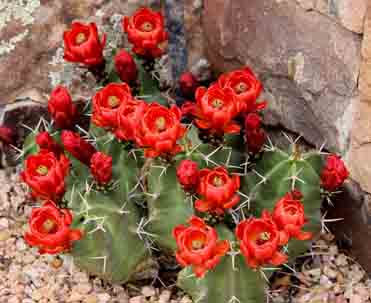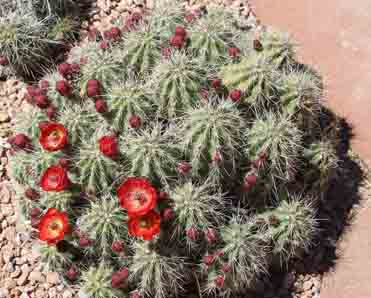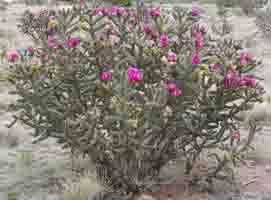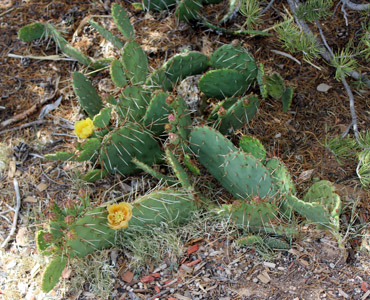Cactus, Texas Prickly Pear - Opuntia phaeacantha
(Ponil)
Food:
"Prickly-pear cacti were widely used for food, though the fruits of these species are smaller and less fleshy than those of their southern relatives. The flavor ranges from bland to sweet to sour and has been likened (at best) to sweet pomegranates. Spines were peeled off, burned or, picked off (with fingers protected by deerskin tips), or removed by sweeping piles of fruit with sagebrush branches. The fruits were then split to remove the seeds and eaten raw (alone or with other fruits), cooked in stews and soups as a thickener, or dried for later use. --- Dried seeds were added to soups and stews or were ground into flour and used as a thickener. Raw cactus stems have been likened to cucumber, but they were usually eaten only when there was a shortage of food. Young segments were boiled and peeled to remove their spines, and the pulpy flesh was fried. Cactus stems have also been pickled or candied."(Kershaw 142-3)
"To enjoy the so-called Indian fig, cut off the ends of these fruits of the prickly pear, slice the hide lengthwise, and scoop out the pulp. Either that, or peel them. A few species, though, are smooth, while others are covered only with bristles that can be easily scraped away as with a bunched handfull of grass. Pleasant raw, the ripe fruit can also be turned into candy or jelly.
The dried seeds are sometimes ground into flour or used to thicken soups. The newer, tenderer pads in particular are sweetly edible once they have been despined when necessary. Sliced, boiled, or roasted, and seasoned, they have proved to be valuable greens in lean times. Although this can be further cooked until it is a rich, dark, highly nutritious paste, some say it is at its best while still a sauce if first allowed to ferment slightly. They also make an interesting pickle.
A bitterish and somewhat sticky juice can be pressed or sucked from the insides of these prickly pear stems and used as emergency water." (Angier 178)
Recipe 1: Grilled Nopale Salsa
(To harvest the fruit or pad, use a sharp knife and make a clean slice about 1" above where it attached to the pad below. Carefully peel the outer layer off the fleshy interior by making one cut down the length and then removing strips of skin with a sharp knife. It is advisable to wear thick protective gloves. To harvest the pads you must remove the small spines, or glochids. The skin can be stripped or left on. Spines can also be scrubbed off with a stiff brush, burned off, or rolled in sand to remove.)
"Remove prickly skins as directed above. Lightly coat inner flesh with oil. Grill gently until just browned. Remove from heat and dice. Combine with equal parts diced, raw tomatoes. Add chopped onion, chopped garlic, and plenty of fresh-squeezed lime juice. Salt and pepper to taste. Serve with grilled chicken or organic corn chips." (Morgan 135)
Recipe 2: Tuna Fruit Salad (the fruit are sometimes called tuna)
"Prepare fruit by stripping the skin as described above. Cut into quarters or, if very large fruits, bite-size pieces. Prepare 2 cups of the cactus fruit. Prepare 1 cup sliced bananas. Squeeze fresh lime juice over the bananas, and toss together gently. Slice enough peaches to make 1 cup. Combine all fruit, and toss gently. Top with pine nuts; serve at room temperature." (Morgan 135)
Recipe 3: Prickly Pear Juice
"Harvest several fruits. Slice them in half. Using a spoon, remove the seeds and then scoop out the fleshy centers. Place 2 cups fruit in a blender with 1 cup water. Blend on medium speed until pulverized. Enjoy as is, or combine with sparkling water to make a spritzer" (Morgan 136)
Medicine:
"The peeled mucilaginous stems were used for dressing wounds or were mashed and placed on aching backs. Stems were also boiled to make a medicinal drink for relieving diarrhea and lung problems and for treating people who could not urinate.
Split stems were placed in containers of muddy water, where they exuded large amounts of mucilage, which cleared the water and made it drinkable.
Freshly peeled stems were sometimes rubbed over painted hides to fix the colors." (Kershaw 142-3)
Other Uses:
"--- at Zuni (Pueblo) the prickly pear fruit may be dried, ground, and dissolved in water with a chunk of dried beeplant to make dye. The mixture creates a reddish shoe polishlike substance that has been used on moccasins. This same prickly pear beeplant combination has also been used to dye thread or weaving fiber." (Dunmire and Tierney 190)
Hedgehog Cactus
 |
 |
Cactus, Claret Cup - Echinocereus coccineus |
Cactus, Claret Cup - Echinocereus coccineus |
Food:
"Hedgehog cacti, with their larger and probably tougher stems, were sometimes roasted in a pit. Years ago ethnobotanist Vlney H. Jones recorded the eating and preserving of the fruits of of one of the hedgehog species, the spectacular Echinocereus triglochidiantus, know as claret cup cactus, at Isleta Pueblo: 'The pulp is prepared in a variety of ways. It may be sliced and baked as squash is prepared. A sweet pickle is made by baking it with sugar. Cakes and candy are made from it in much the same way (Jones, 1931).'" (Dunmire and Tierney 191)
Cholla, Tree - Opuntia imbricata
(Entrana)

Food:
"(Acoma) Young joints split lengthwise, dried, and stored for winter use. Joints roasted and eaten. (Apache, White Mountain) Fruit dried for winter use. Fruit eaten raw or stewed. (Keres, Western) Roasted joints used for food during times of famine. (Papago) Eaten as greens in summer. (Tewa of Hano) Fruits boiled and eaten with sweetened cornmeal porridge." (Moerman 367)
"Historically, cholla is said to have been a famine food. The dethorned joints, flower buds, and fruit were all eaten, but only in time of great need. However, it may have been a common but forgotten staple. A 1915 record at Zuni relates that the fruit was eaten raw and stewed or dried for winter use. The dried fruit was ground into a flour, mixed with parched cornmeal, and made into a mush.
Nowadays, only the buds of this plant tend to be mentioned in cooking recipes." (Dunmire and Tierney 142)
Medicine:
"The brilliant magenta flowers are made into a tea and taken as a diuretic." (Moore 65)
"(Keres, Western) Ground needle coverings made into a paste and used for boils. Dried stem pith used for earache and running ear. Thorn coverings eaten by men in times of war to make them tough." (Moerman 367)
"Drink a tea made from the roots to break up and dissolve kidney stones." (Oscar from Oscars Tree Service, Santa Fe, NM)
Other Uses:
"These are sometimes gathered for canes, picture frames, or as souvenirs; and this probably accounts for its being called cane cactus.
After a particularly bad forage year, ranchers burn off its spines so that their stock may feed on the green stalks.
New Mexicans sometimes use it as a hair tonic. The roots are soaked in cold water for three or four days. Then, to check falling hair and to stimulate growth, the head is first shampooed and afterward rinsed with the infusion." (Moore 65)
"(Keres, Western) Thorns used as sewing material and for tattooing. Dried woody stems used for candles and torches before the presence of other forms of lighting. Red flowers used as an indicator of when to plant beans." (Moerman 367)
